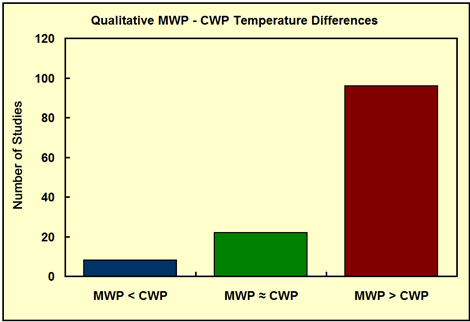High-Arctic Heat Tops 1,800-Year High, Says Study - The Earth Institute - Columbia University
Summers on the Norwegian archipelago of Svalbard are now warmer than at any other time in the last 1,800 years, including during medieval times when parts of the northern hemisphere were as hot as, or hotter, than today, according to a new study in the journal Geology.CO2 Science - MWP-CWP Qualitative Temperature Differentials
“The Medieval Warm Period was not as uniformly warm as we once thought--we can start calling it the Medieval Period again,” said the study’s lead author, William D’Andrea, a climate scientist at Columbia University’s Lamont-Doherty Earth Observatory. “Our record indicates that recent summer temperatures on Svalbard are greater than even the warmest periods at that time.”
The naturally driven Medieval Warm Period, from about 950 to 1250, has been a favorite time for people who deny evidence that humans are heating the planet with industrial greenhouse gases. But the climate reconstruction from Svalbard casts new doubt on that era’s reach, and undercuts skeptics who argue that current warming is also natural. Since 1987, summers on Svalbard have been 2 degrees to 2.5 degrees C (3.6 to 4.5 degrees F) hotter than they were there during warmest parts of the Medieval Warm Period, the study found.
Researchers produced the 1,800 year climate record by analyzing levels of unsaturated fats in algae buried in the sediments of Kongressvatnet lake, in western Svalbard. In colder water, algae make more unsaturated fats, or alkenones; in warmer water, they produce more saturated fats. Like pages in a book, the unsaturation level of fats can provide a record of past climate. So far, most Arctic climate records have come from ice cores that preserve only annual layers of cold-season snowfall, and thus cold-season temperatures. But lake sediments, with their record of summertime temperatures, can tell scientists how climate varied the rest of the year and in places where ice sheets are absent.
...
In looking at how summers on Svalbard varied, researchers also discovered that the region was not particularly cold during another recent anomalous period--the “Little Ice Age” of the 18th and 19th centuries, when glaciers on Svalbard surged to their greatest extent in the last 10,000 years and glaciers in many parts of Western Europe also grew. They suggest that more snow, rather than colder temperatures, may have fed the growth of Svalbard glaciers.
Evidence from tree rings and ice cores shows that southern Greenland and parts of North America were warmer from 950 to 1250 than today, with the Vikings taking advantage of ice-free waters to settle Greenland.
Figure Description: The distribution of Level 2 Studies that allow one to determine whether peak Medieval Warm Period temperatures were warmer than (red), equivalent to (green), or cooler than (blue), peak Current Warm Period temperatures.




No comments:
Post a Comment